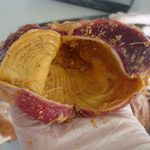 Lacking teeth, a chicken must grind its food in some other way, a process accomplished in its gizzard. Before reaching the gizzard, however, the chicken’s lunch must pass through its craw or crop, a pouch in the bird’s gullet where gastric juice begins to soften the food. (Nowadays, the word craw is best known in exclamations like, “That really sticks in my craw”; the word crop on the other hand, is related to croup, a throat disease in children.) Once in the gizzard, small stones previously swallowed by the chicken grind the food into a paste, which then—a la Jules Verne—completes its journey to the centre of the bird before finding its way back to the surface of the barnyard. The word gizzard derives, through French, from the Latin gigeria, the name of a delicacy made by the ancient Romans from cooked poultry intestines. When it first appeared in English in the early fifteenth century, the name of this poultry organ was spelt giser. The final d that appeared at the end of the word in the sixteenth century is what linguists call a parasite: that is, a consonant that appears when the people who speak the language decide that the word sounds incomplete without it.
Lacking teeth, a chicken must grind its food in some other way, a process accomplished in its gizzard. Before reaching the gizzard, however, the chicken’s lunch must pass through its craw or crop, a pouch in the bird’s gullet where gastric juice begins to soften the food. (Nowadays, the word craw is best known in exclamations like, “That really sticks in my craw”; the word crop on the other hand, is related to croup, a throat disease in children.) Once in the gizzard, small stones previously swallowed by the chicken grind the food into a paste, which then—a la Jules Verne—completes its journey to the centre of the bird before finding its way back to the surface of the barnyard. The word gizzard derives, through French, from the Latin gigeria, the name of a delicacy made by the ancient Romans from cooked poultry intestines. When it first appeared in English in the early fifteenth century, the name of this poultry organ was spelt giser. The final d that appeared at the end of the word in the sixteenth century is what linguists call a parasite: that is, a consonant that appears when the people who speak the language decide that the word sounds incomplete without it.
The very strong muscular stomach of certain birds. Food is mixed with gastric juice and macerated with the aid of small stones, called grit, that are ingested and remain in the gizzard.
